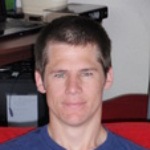1st Mark
2009 |
|
Jakob BLOMER |
CERN, Geneva - Switzerland |
|
 |
I work on the CernVM R&D project in PH-SFT. CernVM provides a portable
environment for development and execution of LHC experiment analysis
software. In particular, I develop the CernVM File System, an HTTP file
system that brings software trees on demand onto virtual machines. As part
of CernVM, I also deal with various aspects of virtualization, including
benchmarks of HEP software in virtualized environments. As part of my
thesis, I work on distributed algorithms in order to build a self-organizing
network of virtual machines out of a plain cluster installation. Currently I
mainly develop system software on Linux using C/C++ and a couple of
scripting languages. I have working knowledge of LateX and Gnuplot.
|
|
2nd Mark
2009 |
|
Nicola CHIAPOLINI |
Universität Zürich - Switzerland |
|
 |
I have been working for the TT sub-detector of LHCb during both my Bachelor
and my Master thesis. Since January I am back with my previous group as a
PhD student. At the time of this writing my work concentrates mostly on the
detector alignment.
|
|
3rd Mark
2009 |
|
Christopher COWDEN |
University of Cambridge – U.K. |
|
 |
CI
am currently working on physics analysis in the Atlas experimental
collaboration. My studies include data driven background estimation
techniques for use in searches for new physics such as supersymmetry, and
separately a measurement of the top quark mass in the dileptonic decay
channel of top pair events. I am familiar with working in the Linux
environment both the Scientific Linux CERN distributions as well as Redhat
Fedora distributions. I am comfortably familiar with the C++ programming
language, and I am also quite familiar with the python scripting language. I
use the bash shell environment for scripting as well.
|
|
|
|
|
Salvatore DI GUIDA |
CERN, Geneva - Switzerland |
|
 |
I am currently working on the development and the deployment of the core
software for the population of DB accounts in different RDBMS technologies
with condition data coming from the CMS detector, using Object Relational
Access. I am also developing tools, which, using the dropbox technology,
allow the automatic population of the Condition Database. All the logs of
the transactions are persistently stored, and monitored by applications that
have a web GUI, thus allowing for real time monitoring, and fast detection
of errors.
|
|
|
|
|
Johanna FLECKNER |
CERN, Geneva - Switzerland |
|
 |
I am currently working on the commissioning of the ATLAS software for the
reconstruction of particle tracks and the identification of b-quarks in
particle jets (b-tagging). As part of this work I am studying the resolution
of the track impact parameter in transverse direction, which is one of the
most important inputs for b-tagging. I am developer of several C++
reconstruction algorithms and tools, and the main responsible for the
production of the b-tagging performance analysis data format (a ROOT ntuple).
I am familiar with Linux, Mac OS X and Windows operating systems. The
largest part of my work concerns programming in C++, but I also have good
knowledge of Python, Delphi, SQL and HTML.
|
|
|
|
|
Pablo GUERRERO |
CERN, Geneva - Switzerland |
|
 |
Last year I finished my Master's Thesis on Computer Science at the Zaragoza
University (Spain) doing an internship as Technical Student at CERN. I
worked developing an automatic solution for the RPM generation process for
different Oracle products, written in object oriented Perl.
After that, I worked for 3 months for Warp, a consulting company
working with Open Source platforms, implementing new features for web
applications written in Python and Ruby. In August 2009, I came back to work
at CERN as Fellow in IT-GT, working for gLite, a Grid middleware used for
the LHC Computing Grid. I am a
member of the gLite integration team, performing the tasks needed to release
new versions of the middleware. I also have to participate in the
modification of the integration process and implement the changes in the
software used in the process.
|
|
|